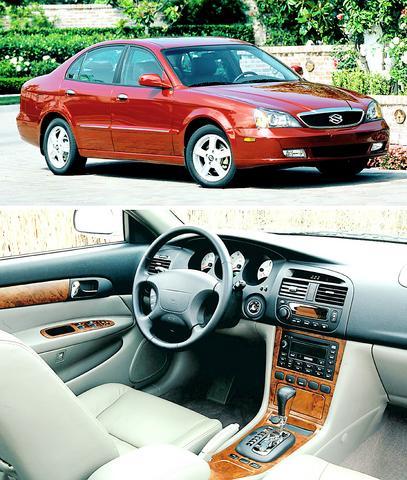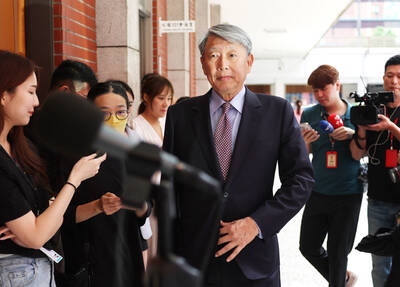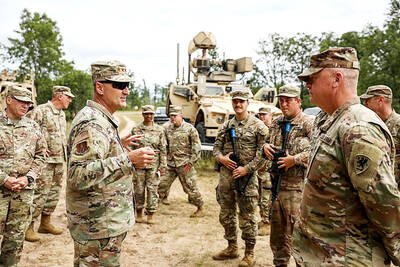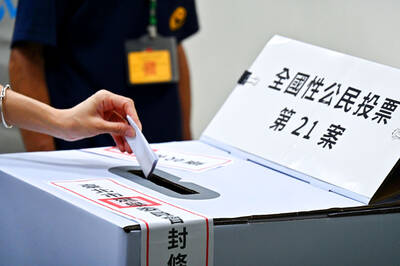In today's global auto industry, Chinese workers bolt bumpers onto Jeeps while Southerners drive Nissan trucks off the assembly line in Mississippi (and polish Mercedes' three-pointed star in Alabama).
But few cars are quite as cosmopolitan as Suzuki's latest sedans, the compact Forenza and midsize Verona.

PHOTO: THE NEW YORK TIMES
Not only were their names inspired by Italian geography, they were styled by Italian designers. They are built in South Korea and sold by a US subsidiary of a Japanese company. Their path to the marketplace began with a complicated deal in which a US conglomerate, General Motors, bought major assets of a bankrupt Korean automaker, Daewoo. GM also owns 20 percent of Suzuki, which helps to explain how the Japanese automaker got a piece of the reconstituted Daewoo pie.
Suzuki's strategy with the Verona and Forenza is similar to that of the South Korean automakers Kia and Hyundai: offer well-equipped models at lower prices and with longer warranties than the Japanese competition. All Suzukis come with a basic warranty of three years or 58,000km and a powertrain warranty of seven years or 161,000km; unlike most warranties, these are transferable when the cars are sold. Buyers also receive free roadside assistance for three years or 58,000km.
After weeklong test drives of both the Forenza and Verona, I concluded that the Suzukis indeed offer a lot of content at a somewhat lower price, with a warranty that should provide some peace of mind. But the cars lack the refinement and engineering sophistication that consumers have come to expect from the Japanese -- and even from some recent US models like the Chevrolet Malibu and Ford Focus.
FORENZA: PLEASING AT FIRST GLANCE
The Forenza takes aim at some well-established small cars like the Toyota Corolla, Honda Civic and Nissan Sentra, and at a glance it seems quite competitive.
The picture darkens a bit when you look at the powertrain. The 2-liter 4-cylinder engine is a modern design (with dual overhead camshafts and four valves per cylinder), but it is rated at just 126 horsepower and 131 pounds-feet of torque. Though many of the Forenza's competitors have smaller engines, they manage to squeeze out as much power, or more; the Focus gets 10 more horsepower out of the same size engine.
The front-drive Forenza not only feels underpowered, its government fuel economy ratings are the lowest in the class; 39km per gallon in the city and 50km per gallon on the highway (with a five-speed manual transmission). Mileage of comparable compact sedans falls broadly in a range of 42kpg to 64kpg.
While a Forenza owner will be making more stops at gas stations than those who drive Civics, he or she will ride in reasonable comfort. The cabin is attractively appointed with high-quality materials, comfortable seats and extremely good fit-and-finish. At .35m3, the trunk space is on par with that of other compact cars, and the rear seats fold nearly flat, adding to the potential cargo capacity.
The Forenza comes fairly well equipped with one glaring exception: it does not offer side air bags or side curtain bags. In government crash tests, the Forenza scored four out of five possible stars for front passengers but only three stars for side impacts.
The Forenza starts at US$13,994 including destination charge and tops out around US$18,000. My test car, a "desert green" LX with manual transmission, was well equipped without benefit of options for a price of US$14,395. So for less than US$15,000 you get a complete car you can probably live with, plus a long warranty and free roadside assistance.
VERONA: LOW PRICE, LESS POWER
The midsize Verona is pitted directly against the Toyota Camry, Honda Accord and Nissan Altima. Like the Forenza, it is pleasing to look at, but hardly a knockout.
The Verona's interior space essentially matches the Camry's, which is to say it is more than adequate for most people in the market for a midsize sedan. The controls are good and the general environment is quite comfortable -- relatively upscale, even.
The front-drive Verona has an in-line 6-cylinder engine, unusual in a class where V-6's dominate. The 2.5-liter power plant is a new design developed with help from Porsche, with dual camshafts and 24 valves. While in-line 6's are typically smoother and quieter than V-6's, the Verona's was noisier and rougher-running than I had anticipated. The Verona's ride and handling are decent, however, even though the car's suspension is tuned more for comfort than for sport.
Like the Forenza, the Verona comes in three versions: base S, midlevel LX and top-of-the-line EX. Base prices, including delivery charges, range from US$17,994 to US$21,494. A top-of-the line EX tops out at US$21,494.

CHIPMAKING INVESTMENT: J.W. Kuo told legislators that Department of Investment Review approval would be needed were Washington to seek a TSMC board seat Minister of Economic Affairs J.W. Kuo (郭智輝) yesterday said he received information about a possible US government investment in Taiwan Semiconductor Manufacturing Co (TSMC, 台積電) and an assessment of the possible effect on the firm requires further discussion. If the US were to invest in TSMC, the plan would need to be reviewed by the Department of Investment Review, Kuo told reporters ahead of a hearing of the legislature’s Economics Committee. Kuo’s remarks came after US Secretary of Commerce Howard Lutnick on Tuesday said that the US government is looking into the federal government taking equity stakes in computer chip manufacturers that

NORTHERN STRIKE: Taiwanese military personnel have been training ‘in strategic and tactical battle operations’ in Michigan, a former US diplomat said More than 500 Taiwanese troops participated in this year’s Northern Strike military exercise held at Lake Michigan by the US, a Pentagon-run news outlet reported yesterday. The Michigan National Guard-sponsored drill involved 7,500 military personnel from 36 nations and territories around the world, the Stars and Stripes said. This year’s edition of Northern Strike, which concluded on Sunday, simulated a war in the Indo-Pacific region in a departure from its traditional European focus, it said. The change indicated a greater shift in the US armed forces’ attention to a potential conflict in Asia, it added. Citing a briefing by a Michigan National Guard senior

POWER PLANT POLL: The TPP said the number of ‘yes’ votes showed that the energy policy should be corrected, and the KMT said the result was a win for the people’s voice The government does not rule out advanced nuclear energy generation if it meets the government’s three prerequisites, President William Lai (賴清德) said last night after the number of votes in favor of restarting a nuclear power plant outnumbered the “no” votes in a referendum yesterday. The referendum failed to pass, despite getting more “yes” votes, as the Referendum Act (公民投票法) states that the vote would only pass if the votes in favor account for more than one-fourth of the total number of eligible voters and outnumber the opposing votes. Yesterday’s referendum question was: “Do you agree that the Ma-anshan Nuclear Power Plant

ENHANCED SECURITY: A Japanese report said that the MOU is about the sharing of information on foreign nationals entering Japan from Taiwan in the event of an emergency The Ministry of Foreign Affairs yesterday confirmed that Taiwan and Japan had signed an agreement to promote information exchanges and cooperation on border management, although it did not disclose more details on the pact. Ministry spokesman Hsiao Kuang-wei (蕭光偉) said the ministry is happy to see that the two nations continue to enhance cooperation on immigration control, in particular because Taiwan and Japan “share a deep friendship and frequent people-to-people exchanges.” “Last year, more than 7.32 million visits were made between the two countries, making it even more crucial for both sides to work closer on immigration and border control,” he said. Hsiao